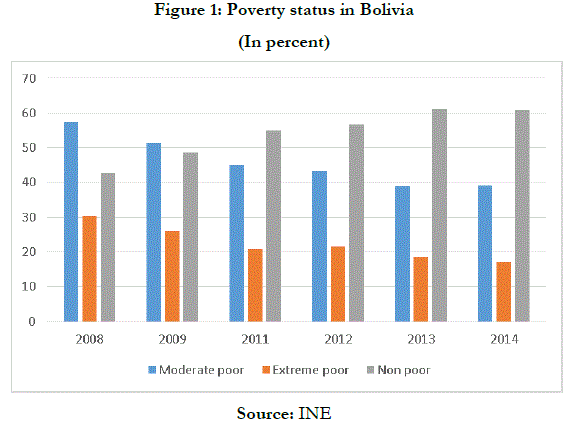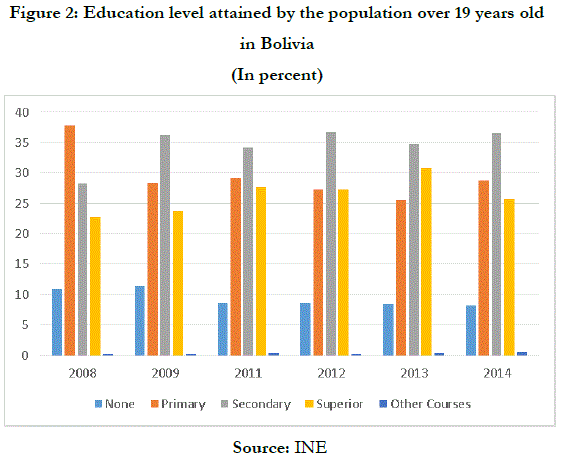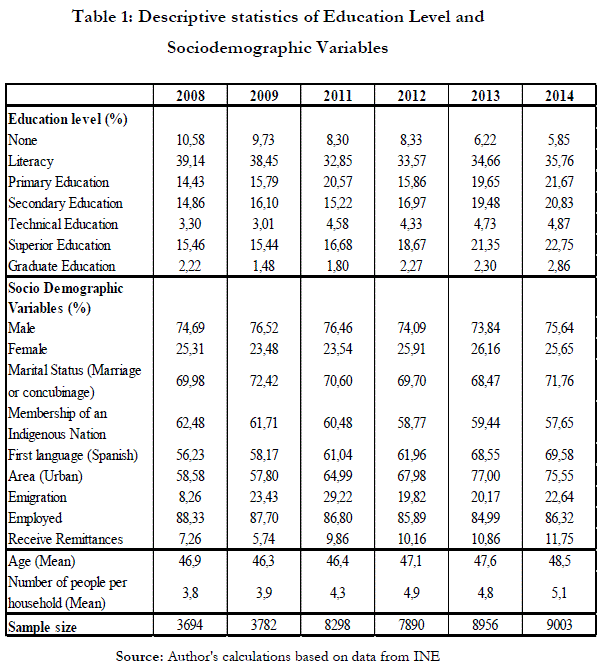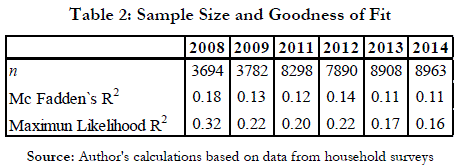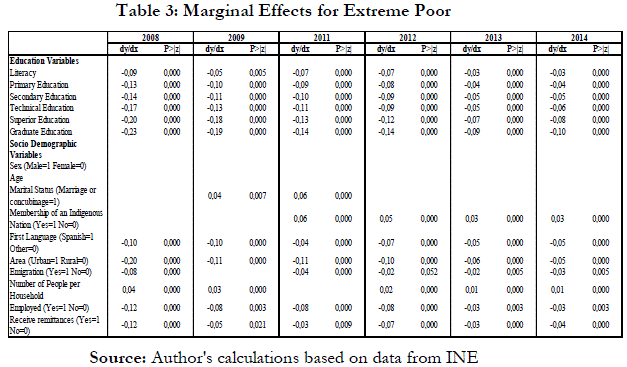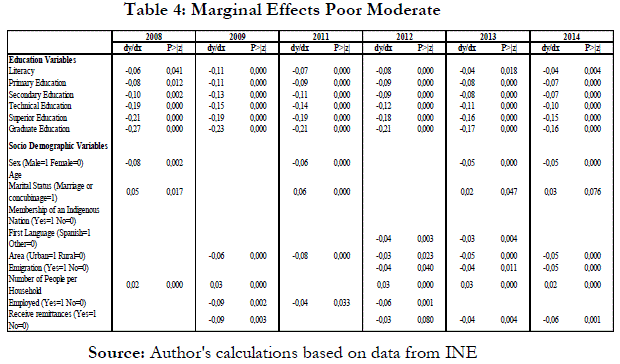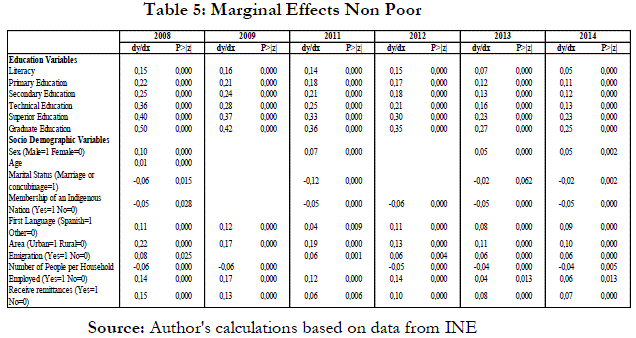Servicios Personalizados
Revista
Articulo
Indicadores
-
 Citado por SciELO
Citado por SciELO -
 Accesos
Accesos
Links relacionados
-
 Similares en
SciELO
Similares en
SciELO
Compartir
Economía Coyuntural
versión impresa ISSN 2415-0622versión On-line ISSN 2415-0630
Revista de coyuntura y perspectiva vol.1 no.4 Santa Cruz de la Sierra 2016
ARTÍCULOS ACADÉMICOS
Impacto de la educacion sobre la pobreza en Bolivia
Impact of education on poverty in Bolivia
Horacio Villegas Q.ψ Jaime Vargas R.ξ David Perez O.δ
ψ Professor and Researcher at Bolivian Catholic University
ξ Professor and Researcher at Bolivian Catholic University
δResearcher
Recepción: 03/09/2016 Aceptación: 29/10/2016
Abstract: This research evaluates the impact of education levels (literacy, primary, secondary, technical, higher and postgraduate) on poverty in Bolivia during 2008, 2009, 2011, 2012, 2013 and 2014. The investigation also uses various sociodemographic variables describing households to see their impact on poverty. The results indicate that there is a clear link between education and poverty, where technical, higher and postgraduate education variables had the highest incidence. In analyzing the results as a whole, it appears that education becomes an effective tool to overcome poverty.
Keywords: Poverty, Education, Multinomial Logit, Bolivia.
Clasificación Jel: I21,I25,I32.
Introducción
Different development theories attribute to education a central role in economic growth, welfare and human development. International organizations like the UN, IADB, UNESCO and ECLAC highlight the importance of education as a key element in reducing extreme poverty (Ordaz, 2009). Sen (1999) argued that improving basic education not only increases the quality of life directly, but also the ability of a person to earn an income and get rid also of income-based poverty; higher levels of education lead to an improvement in the quality of labor (higher productivity of this factor). This improvement is rewarded in the labor market with greater returns to human capital, i.e. with higher wages. If an (initially) poor person invests in education, she expects an improvement in their income as retribution, which automatically has an effect on their probability of being non-poor.
On the other hand, from the nineties, education has played a fundamental role in the global agenda against poverty. Education becomes a central and strategic factor for socio-economic development of any country, one of the basic components of investment in human capital as well as being a powerful tool for boosting productivity and competitiveness of developing countries (Rosales, 2006). Several countries have designed programs to combat poverty in order to improve human capital, building schools close to the poorest sectors, provide economic incentives for teachers or grant cash transfers to families who send their children to school (Ordaz, 2009).
In the case of Bolivia, education has experienced a breakthrough on the issue of literacy in the past two decades; According to the National Census of Population and Housing in 1992, 20 out of 100 people were illiterate, while in 2012 the number decreased to 5 out of 100. This shows a reduction of 15 percentage points over a period of 20 years. Moreover, the enrolled population in Bolivia grew 5.3% from 2008 to 2013 (INE, 2014). This reflects the increased coverage of the education system in Bolivia.
The economic context allowed a substantial reduction on moderate poverty from 63% in 2002 to 45% in 2011, while the Gini inequality index fell from 0.60 to 0.49 between 2002 and 2013. These notable results may be due to different economic and social variables as well as public investment. This paper focuses on educational variables that affect poverty.
This research seeks to determine the impact of education on the probability of being poor. The document presents a disaggregation by educational cycles to determine the importance of each of these on the probability of being poor. Also, the study separates the sample into 3 groups: poor (moderate and extreme) and non - poor, estimating the educational impact for each group. In addition, the relationship between poverty and education will be observed using 2008, 2009, 2011, 2012, 2013 and 2014 household surveys (MECOVI), analyzing the evolution of the impact of education on poverty in this period.
The paper is organized as follows: chapter 2 presents the literature review, a brief analysis of the database on poverty and education will be presented in chapter 3, while chapter 4 will describe the econometric model. Finally, the fifth chapter presents the results and chapter 6 includes the conclusions and recommendations.
2. Literature review
In different periods and countries, various studies attempted to measure the influence of education on poverty, and show welfare gains, higher level of wages, lower unemployment rates and higher status for those with more education. Some of them are detailed below.
For the nineties, CEPAL1 shows data from several countries (Brazil, Colombia, Guatemala, Honduras, Panama, Uruguay, Venezuela, Costa Rica and Chile) and concludes that in the region, 10 or more years of study, culminating preferably secondary, were necessary to access higher welfare, translated into 80% chance of not falling into poverty. Data from Uruguay and Venezuela show that the social stratum of the parental home, continues to condition the educational opportunities of the children. Only one in four young people aged 15 to 19, whose father did not complete primary education, were studying school without delay, and where the parent education exceeds secondary that proportion rises to three out of four young people.
In this line, Appleton (2001) performed an analysis in the 1990s in Uganda, and shows how the growth of living standards and reducing poverty during that period had more impact on households with higher levels education. This author found direct productivity effects of education that increased over time.
Verner (2004), analyzes the case of Paraiba (Brazil) and reveals that education is the most important factor for poverty reduction. All levels of education (primary, secondary and tertiary) are significant and negatively associated with the probability of being poor. He states that the higher the education level, the lower the probability of being below the poverty line. With secondary education completed the probability of being poor is four times lower relative to completed primary education. The probability of being poor having completed tertiary education, according to his calculations, is six times lower relative to completed primary education.
On the other hand, Knight et al. (2008) performed an analysis in rural China, which connects education and poverty to the formation of a system. The scenario presented in rural China shows a high enrollment of the population compared to most poor rural societies, but this research examined the variables of quality, quantity and parental education. The main results, note that the low parental education, low quality and low amount reduce the chance of being non-poor, leading to have poor health, low income and reduced welfare.
Ordaz (2009) presents a study which assesses the impact of primary and secondary education in the rural sector in Mexico on three levels of poverty: food, capabilities and patrimony poverty. He finds a positive impact of education in reducing poverty, with greater impact when it comes to secondary rather than to only primary. For the rural sector, it concludes that when the average person has completed primary the likelihood to be in food poverty decreases 7.3 percentage points, 8.3 in capabilities poverty and 6.1 in patrimony poverty. Secondary reduces 10.1 percentage points the probability of being in food poverty, while the reduction in capabilities and patrimony poverty decreases 11.2 and 9.6 percentage points, respectively.
Borraz et al. (2010) evaluated the role of education systems as a mechanism to improve people welfare in different countries of Latin America. They determine the returns to formal education in six countries: Argentina, Brazil, Colombia, Paraguay, Peru and Uruguay. The authors consider that the observed high levels of returns to secondary education is particularly indicative that education can be an effective opportunity for disadvantaged individuals in society access to better job opportunities. Their work looks at the impact of education in different levels of income, and consider important to understand the design of educational policies that favor the creation of opportunities for those individuals located in the lower segments of the income distribution.
Maliki et al. (2012) quantify the relationship between poverty and education in the region of Tlemcen (Algeria). They find that education plays a vital role in economic and social development. They perform a multinomial regression where the dependent variable has four alternatives (very poor, poor, intermediate and rich) different situations. They conclude that higher levels of education lead to increases in productivity and income, thus reducing inequality and poverty.
Imran and Ullah (2012) performed an analysis in the region of Punjab (India), which shows the importance of education to address the incidence of multidimensional poverty. Their results show consistently that the incidence of multidimensional poverty was higher in rural areas, where education has an important role. They also analyze other both regional and demographic variables that define the state of poverty and show that there is a strong need to address the educational dimension of the poor, since the human capital plays a vital role in improving the welfare and living conditions.
For the case of Bolivia, Zambrana (2010), by analyzing determinants of poverty, notes that years of schooling provide great significance to define people within a non-poverty range. Recently, Bernal (2014) shows that each additional year of education decreases by 1.84% the probability of being poor.
3. Poverty and education database analysis
Figure 1 shows a sharp decrease in the percentage of people living above-poverty line in Bolivia, where the percentage of non-poor increased from 43% in 2008 to 61% in 2014, an increase of 18 percentage points (the opposite happened to the moderate poor). On the other hand, extreme poverty showed a significant reduction from 30% in 2008 to 18% in 2014, a decrease of 12 percentage points in just five years. It's important to highlight these positive developments, as they help to understand the results of this paper.
Figure 2 shows that in 2008 only 28.3% of people completed secondary education while in 2014, 37% did, with an increase of more than 8 percentage points in a 6-year period. On the other hand, primary education there was a decrease from 37% in 2008 to 28% in 2014, which can be explained by the increase of the number of people over 19 who completed secondary education. It's important to highlight that higher education only had an increase of 3 percentage points, from 22% in 2008 to 25% in 2014.
4. Data
The information used for this research was obtained from the 2008, 2009, 2011, 2012, 2013, and 2014 household surveys. This survey is intended to collect information on the living conditions of the Bolivian population for the generation of indicators of poverty and the consequent formulation of policies and programs that contribute to improving the well-being conditions of the households. The sample used includes the head of household of each family, and specific characteristics such as educational level, gender, age, marital status, membership of an indigenous people, language, area, migration, work, remittances and number of people in the household.
Table 1 shows the levels of education achieved by the head of household as well as sociodemographic variables. At the first glance it can be observed that the proportion of heads of households who did not obtain any level of education has been reduced by 4.7 percentage points during the 2008-2014 period. Among the educational variables, primary education had the highest growth, with an increase of 7 percentage points.
It is observed within the sample that the highest percentage of heads of households for all years correspond to men while women only represent around 25% each year. In the case of civil status the largest proportion corresponds to those who are married or live in concubinage. The membership to an indigenous nation has been considerably reduced from 62.5% in 2008 to 57.6% in 2014, showing a decrease of 4.9 percentage points.
The largest number of people in the sample resides in the urban sector. On the other hand, in the case of emigration, there was an increase from 8.3% in 2008 to 20.6% in 2014 and remittances have increased slightly in the same period. The average age of head of household is around 47 years and the average number of people living in the household is between 4 and 5.
5. Econometric model
5.1. Logit Model
This model provides estimates of the probability of an event, identifying risk factors that determine these probabilities as well as the influence or relative weight that they have on them. This type of model yields results as an index, whose determinants are known, which are sortable and through a stratification method, generate classifications in which each element is associated with a rating.
It is a non-linear model, the data do not fit a straight line and explanatory variables are not required a determined distribution. It allows to build models where the dependent variables can be quantitative or qualitative, the latter can be dichotomous, and within these variables they may be ordinal or nominal and explanatory variables can be qualitative and/or quantitative.
The logistic function is a sigmoid S-shaped curve and the model can be linearized using logarithms. If the dependent variable is dichotomous, it is used to predict the estimated probability that the dependent variable "Y" presents one of the possible values bounded between 0 and 1 depending on the different values taken by the set of independent variables "Xki".
For Logit model, the function used is the logistic, with the following specification:

The Logit model can be interpreted in probabilistic terms, to measure the probability of the occurrence of the event. As for the interpretation of the estimated parameters in a Logit model, their sign indicates the direction in which the probability moves when the corresponding explanatory variable increases.
5.2. Multiple Response Model
When the endogenous variable is discrete with several possible answers we are faced with multiple choice models. These models are classified into two groups as the endogenous variable can be sorted (sorted data models) or cannot be sorted (models with non-sorted data).
In this paper a Multinomial Logit model for unsorted data is used.
5.2.1. Multinomial Logit regression model
The Multinomial Logistic regression is a classification that generalizes the logistic regression method to multiple problems, for more than two possible discrete results. It is used to predict the likelihood of possible outcomes of a categorical dependent variable, given a set of independent variables.
The formulation of a Multinomial Logit model is:

Where y is the index associated with each alternative and ranges from 0 to (J-1). The vector of parameters has an associated subscript corresponding to the concrete alternative analyzed. The estimated equations provide a set of probabilities for each of the alternatives that can take an individual i with Xi individual characteristics.
The Multinomial Logit model is indefinite while trying to estimate the value of the parameters. To solve this problem the model is normalized taking the zero value, ß0 = 0, for the parameters that accompany the zero alternative.
The resulting probabilities are:
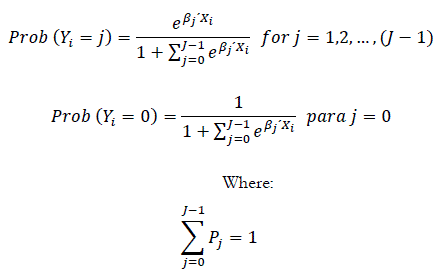
For the simple case of a model in which the endogenous variable has three possible alternatives of choice and there is only an explanatory variable, the probability associated with each of the possible alternatives of choice would take the following expressions2
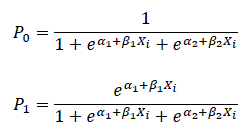

5.3. Model Specifications
The heads of households are considered for the model estimation
The structured model is:

Dependent variable:
Pconp: It represents the condition of poverty, where Non poor = 1, Moderate poor = 2, and extreme poor = 3.
Independent Variables:
literacy: Refers whether the person is literate, where Yes = 1; No = 0
primary education: Refers to primary education where Primary concluded = 1; Not completed primary = 0
secondary education: Refers to the secondary school where Secondary concluded 1; Not completed secondary = 0
technical education: Refers to technical education where Technical Education concluded = 1; Technical education not concluded = 0
superior education: Refers to higher education where, Concluded - 1; Not concluded = 0.
graduate education: Refers to graduate education where, Concluded = 1; Not concluded = 0.
sex: Refers to the genre where Man = 1 and Female = 0
age: Variable to indicate the age of the head of household
marital status: Refers whether the head of household lives with someone, where married or Conjugal Coexistence = 1 and another case = 0
membership of an indigenous nation: Refers whether the person belongs to a native nation, Yes = 1; No = 0
first language: Refers to the first language where Spanish = 1; Other = 0
area: Refers whether the person belongs to the urban area = 1; rural area = 0
emigration: Refers whether the person has migrated over the past five years where Yes = 1; No = 0
number of people per household: Refers to the number of inhabitants per household
employed: Refers whether the person is currently working, Yes - 1 and No -0
receive remittances: Refers whether the person has received remittances in the last year, where Yes = 1; No = 0
6. Results
As the dependent variable is discrete with 3 alternatives (Non Poor, Moderate Poor and Extreme Poor), Se aplico el modelo Logit Multinomial debido a que la variable dependiente es una variable discreta con 3 alternativas respectivamente (No Pobre, Pobre Moderado y Pobre Extremo), nos encontramos ante un modelo de respuesta multiple con datos no ordenados y por dicho motivo se uso el modelo mencionado.a Multinomial Logit model was applied. The estimation requires that one of the specific poverty variables is omitted, so the Non Poor variable was chosen in order to measure the different conditions relative to this alternative.
Table 2 presents the sample size used in each estimate, as well as the traditional McFadden R2 and maximum likelihood R2
Since 2011 the sample size practically doubled, reaching almost 9,000 observations in 2014. The McFadden R2 shows relatively low levels of goodness of fit between 11% and 18%. However, the maximum likelihood R2 presents a more optimistic scenario showing adjustments up to 32%. However, both measures are decreasing over time.
Extreme Poor
Table 3 shows the marginal effects for the Extreme Poor. For the years 2008, 2009, 2011, 2012, 2013 and 2014 there is a negative relationship between educational variables and the Extreme Poor condition. In 2008, completed literacy showed a marginal effect of 9% to overcome extreme poverty while graduate completion had a marginal effect of 23%. Therefore, there was a 14-percentage-point difference between completed literacy and postgraduate education.
It's important to highlight that graduate education has the greatest influence within educational variables, which means that having graduate education increases the probability of overcome extreme poverty. The fact that the magnitude of the variables decreased over time can be explained by the decrease in extreme poverty and the increase in the number of people at different educational levels (Olavarricia, 2005).
The results also show that gender status an age are irrelevant and insignificant to explain extreme poverty. Marital status has a positive relationship with the Extreme Poor condition in 2009 and 2011, which indicates that people who are married or living with someone tend to be extremely poor, for the remaining years there is no influence on the probability of being extremely poor.
Membership to an Indigenous nation has also a positive relationship with the Extreme Poor condition for the last three years, so indigenous people are more likely to be extremely poor. Language, Area and Migration have a negative relationship with the Extreme Poor condition, which clearly indicates that people living in urban areas, that speak Spanish as their mother language and migrated, are more likely to be far away from extreme poverty. On the other hand, the Area variable has the highest incidence among sociodemographic variables, with an incidence of 20% for 2008. The probabilities for these variables have been declining from 2008 to 2014.
In the case of Total number people in Household, there is a positive relatively constant relationship with the Extreme Poor condition over the years. This indicates that more people at home increases the chances of being extremely poor. Finally, the results also show that people who work and receive remittances are away from extreme poverty.
Moderate Poor
Table 4 shows the marginal effects for the Moderate Poor condition. As in the Extreme Poor one, education is negatively related to this condition. The marginal effects show that higher levels of education increase the probabilities to overcome moderate poor. In 2008 being literate increased 6% the probability of overcome moderate poverty, while completion of graduate education had an impact of 27%. For 2014, the marginal impact was 4% and 16%, respectively which implies 2% and 10% gain. The results show that graduate education is the variable with the highest incidence in the model. Just as for extreme poverty, the value of variables tends to fall by the decrease in moderate poverty and the increased number of people at different educational levels.
Among sociodemographic variables, a negative relationship was found for Gender the years 2008, 2011, 2013 and 2014, which indicates that men have higher chances to overcome moderate poverty. Age is not significant, while marital status has positive association with the Moderate Poor condition in 2008, 2011, 2013 and 2014, which indicates that people who are married or living with someone tend to be moderate poor. Belonging to an indigenous nation has no significance for any year.
Language has significance for the last two years, where a negative relationship with the Moderate Poor condition was obtained, therefore having Spanish as mother language is good to overcome moderate poverty. Area has significance for the last 5 years and has negative sign, which suggests that living in urban areas decreased the probability of being moderate poor. Migration has a negative relationship with Moderate Poor condition in the last 3 years, so people who migrate are more likely not to be moderately poor.
Finally, the results show that increasing the number of people at home is associated to moderate poverty. Work and remittances are negatively related, which shows that working people or people that receive remittances tend to leave moderate poverty.
Non poor
Table 5 shows the marginal effects for the Non Poor condition in 2008, 2009, 2011, 2012, 2013 and 2014. It can be seen that the educational variables are positively associated with the probability of being Non Poor, so getting higher education increases the probability to be not poor. Literacy has maintained a positive relationship over the years studied, involving significant percentages for each year, in 2008 had a 15% contribution for not being poor and the number was reduced to 5% in 2014 due to an increase in the literacy rate in the country, but its incidence is still important.
Primary education got positive signs. In 2008 it represented a 22% of probability of not being poor and this number decreased to 11% in 2014. For secondary education the values were 25% and 13%, respectively. The decrease can be attributed to lower levels of poverty in the country as well as more people finishing school.
Technical and Graduate Education got high contributions to the probability of being not poor in all the years. However, Graduate Education was the variable with the greatest contribution within the model and every year, contributing up to 50% for 2008 and 25% for 2014. While all of these variables have been declining, they have always represented the highest percentage which indicates that at the end of each level, the probability of being not poor increases. The analysis of the relationship between education and poverty levels suggest that people with high education levels can easily be non-poor.
The results show that being male decreases the probability of being poor, however for 2009 and 2012 the gender variable was not significant. The Age variable remains positive but its contribution to the probability of being poor is negligible. The marital status showed a negative trend for people who were married or cohabiting, which shows that people who live without a partner are more likely to be non-poor.
Another variable with negative trend was the belonging to a native nation, which maintained a similar value for most of the study years. Language has also maintained a positive relationship with the non-poor status for people whose mother language is Spanish. Among sociodemographic variables, Area had the highest incidence, which suggests that living in urban areas increases the probability of being Noon Poor. Migration also had a positive and steady contribution.
Finally, labor activity maintained a positive value for the years of analysis, since they receive financial remuneration for their work, but this incidence is not as high as the educational variables ones. Remittances intuitively have a positive contribution to the household, reducing the poverty levels.
To conclude this section, we must observe an element that caught our attention: the temporary decrease in the incidence of education in the probability of being poor. This fact is observed throughout the period of analysis for all groups (moderate poverty, extreme poverty and non-poor). This decline is evident both in the basic level of education as well as in the higher education. However, the larger gaps correspond to the latter.
7. Conclusions and recommendations
7.1. Conclusions
The research developed in this paper evaluates the relationship between different levels of education (literacy, primary, secondary, tertiary and postgraduate) and the condition of poverty in Bolivian households. The analysis also considered the characteristics of the head of the household in order to have more accurate results. Based on research considering 2008, 2009, 2011, 2012, 2013 and 2014, it was shown that educational variables have a significant influence on the probability of overcoming poverty, where the higher level of education had the highest contribution.
The investigation applied a Multinomial Logit model. The results show that education is important to reduce moderate and extreme poverty. In addition, for the extreme poverty case, gender is not significant while for the moderate poverty one, ethnicity is not significant.
It is important to note the diminishing trend of the variable values from 2008 to 2014, and this can be explained by the sharp reduction on extreme and moderate poverty in Bolivia as well as by an increase in the number of people accessing the different levels of education (Olavarria, 2005).
The results show that the probability that a household is considered as Non Poor, depends on educational variables. The incidence of literacy increased from 15% in 2008 to 5% in 2014. For primary education, the incidence was 22% in 2008 and 11% in 2014, while for secondary education the values were 25% in 2008 and 12% in 2014.
The most significant effects were on tertiary and postgraduate education. Technical education showed a contribution of 36% in 2008 and 13% in 2014. Higher education reached 40% in 2008 and 23% in 2014. Graduate education was the most influential in the model, with values of 50, 42, 36, 35, 27 and 25 percent for each year respectively.
For the other variables under study, the results show that indigenous women that doesn't speak Spanish and live in rural areas have higher probabilities of being poor, which implies that there is still a non-inclusive environment for people with certain social characteristics. In the case of marital status, married people are more likely to be poor.
The results also show that people who migrate, work and receive remittances have better living conditions. It is important to note that the impact of these variables is not as significant as the educational variables one.
The results of this investigation confirm that there is a clear link between education and poverty in Bolivia, where the higher the level of education, the higher the value of the probability of being not poor.
7.2. Recommendations
Based on the results, we can recommend the continuation of policies that promote further education of the population, since tertiary and postgraduate education have the greatest impact on poverty reduction. It's also important to reduce non-inclusive patterns based in gender, ethnicity, language and area in order to reduce poverty levels.
It is also advisable to conduct research to see how these variables operate within different departments and areas (rural and urban), in order to design different programs within the local governments and municipalities. It is important to expand the education databases to strengthen the research capabilities on education-based intergenerational poverty transference, impact of education quality on poverty, development and private and public education in order to better address educational policies.
Moreover, future research could complement the results of this study through the use of other econometric techniques such as pseudo-panels using cohorts in the household surveys.
Notas
1 CEPAL, Panorama Social de America Latina 1990
2 The parameters that correspond to the independent term will be identified with a, while p will be used to parameters that correspond to explanatory variables.
References
Aguado, L., Giron, L. & Salazar, F. (2006). “Una aproximación empírica a la relación entre educación y pobreza”. Pontificia Universidad Javeriana, Colombia.
Appleton, Simon (2001). “Education, Incomes and Poverty in Uganda in the 1990s”. Centre for Research in Economic Development and International Trade. University of Nottingham.
Arias, Carmen & Molinas, Margarita (2012). “Pobreza en Paraguay: Contribución de la educación media en el acceso a las oportunidades para superar la pobreza”. Universidad Nacional de Asunción.
Azucena, Lanny (2013). “Pobreza y educación en Panamá: un análisis cuantitativo”. Escuela Agrícola Panamericana, Honduras.
Banco Central de Bolivia (2013). “Principales logros económicos y sociales 2006-2013”
Bernal, Ernesto (2014). “Impacto de la Educación sobre la Pobreza y la Desigualdad en Bolivia”. Instituto de Investigaciones Económicas. Universidad Técnica de Oruro.
Bilenkisi, F., Sami, M. & Tapsin, G. (2015). “The Impact of Household Heads’ Education Levels on the Poverty Risk: The Evidence from Turkey”. Educational Sciences, Theory & Practice, Turkey.
Borraz, Fernando. et al. (2010). “Pobreza, Educación y Salarios en América Latina”. Universidad de Montevideo.
Carm, E., Mageli, E., Nyman, L. & Smith, R. (2003). “Education and its Impact on Poverty: An Initial Exploration of the Evidence”. The International Education Centre at Oslo University.
Coley, Richard & Baker, Bruce (2013). “Poverty and Education: Finding the Way Forward”. Education Testing Service, USA.
Del Cisne, Johanna (2010). “Efectos de la educación en el nivel primario, secundario y superior, y las condiciones de empleo, en la dinámica de la pobreza en los hogares de la provincial de Loja en el año 2001”. Universidad Técnica Particular de Loja.
Diawara, Barassou (2011). “The Role of Education on Poverty Reduction in Senegal”. Kyushu University, Japan.
Fedriani, E. & Martín, A. (2001). “Modelos de Cuantificación de la Pobreza”. Universidad Pablo de Olavide.
Imran, M. & Ullah, A (2012). The Impact of Education on Multidimensional Poverty across the regions in Punjab”. Journal of Elementary Education Vol.21, N° 1 pp. 77-89
Instituto Nacional de Estadística de España (2012). “La Pobreza y su Medición. Presentación de diversos métodos de obtención de medidas de pobreza”
Ivette, Ligia (2013). “Determinantes de la pobreza rural: Una aplicación a Nicaragua”. Universidad de Córdoba, España.
Knight, J., Shi, L. & Quheng, D. (2008). “Education and the Poverty Trap in Rural China”. University of Oxford.
Larrañaga, Osvaldo (1997). “Educación y superación de la pobreza en América Latina”. Programa de las Naciones Unidas para el Desarrollo.
López, L. & Murillo, O. (2006). “La Reforma Educativa Boliviana: Lecciones aprendidas y sostenibilidad de las transformaciones”.
Maliki, S., Benhabib, A. & Bouteldja, A (2012). “Quantification of the Poverty-Education Relationship in Algeria: A Multinomial Econometric Approach”. University of Tlemcen, Laboratory MECAS, Algeria.
Mesa, C., Mesa, J & Gisbert, T. (2001). “Historia de Bolivia”.
Mogrovejo, Rodrigo. (2010). “Las políticas educativas en Bolivia como estrategias de lucha contra la pobreza. Diversidad de enfoques e influencia de la cooperación internacional (1994-2010). Universidad del País Vasco.
Olavarricia, Mauricio (2005). “Pobreza, Crecimiento Económico y Políticas Sociales”. Universidad de Chile.
Ordaz, Juan (2009). “México: Impacto de la educación en la pobreza rural”. CEPAL-Serie Estudios y Perspectivas – México – N° 105.
Otero, Gerardo. et al (2002). “Pobreza: definición, determinantes y programas para su erradicación”. Ministerio de Economía de la Provincia de Buenos Aires, Argentina.
Rocha, Sonia (2007). “Pobreza, Socializacion y Movilidad Social”. Universidad Iberoamericana.
Rodríguez, Mónica (2012). “Educación y Pobreza. Un Análisis de Eficiencia Relativa Departamental”. Universidad Nacional de Colombia.
Romero, Milton (2007). “Exclusión en el Sistema Educativo en Bolivia”. Universidad Católica Boliviana.
Sen, Amartya (1976). “Poverty: An Ordinal Approach to Measurement”. Econometrica. Vol. 44, N°2, 219-231.
Sen, Amartya (2000). “Desarrollo y Libertad”
Tarabini-Castellani, Aina (2008). “Educación, pobreza y desarrollo: Agendas globales, políticas nacionales y realidades locales”. Universidad Autónoma de Barcelona.
Tarabini-Castellani, Aina (2011). “El binomio educación-pobreza: un análisis de su papel en la agenda global de desarrollo”. Instituto Politécnico Nacional, México.
Teitelboim, Berta (2006). “Factores concluyentes de la pobreza en base a un modelo logístico”. Universidad de Chile
Verner, Dorte (2004). “Education and Its Poverty-Reducing Effects: The Case of Paraiba, Brazil”. World Bank Policy Research Working Paper 3321.
Villarroel, Edith. “Historia de la Educación”. Universidad Autónoma Gabriel Rene Moreno, Bolivia.
Zambrana, Rafael (2010). “Determinación de la pobreza en las familias Bolivianas”. Universidad Mayor de San Andrés.













